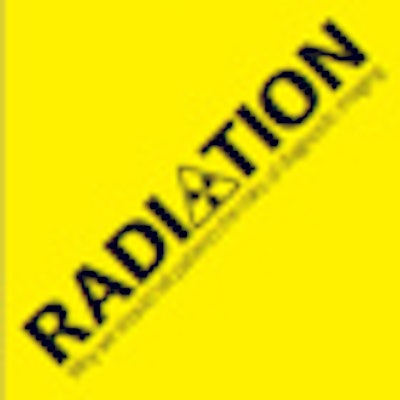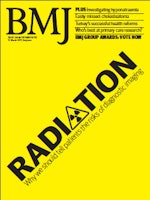
A review article in the March 12 edition of the British Medical Journal (BMJ) addresses the topic of radiation risks from radiological imaging, providing an overview of what's known about the cancer risk from radiation, and what healthcare providers can do to minimize it.
The article describes the factors contributing to rising demand for imaging, with the use of CT doubling in the U.K. during the last decade, and growing more than 20-fold in the U.S. during the past 30 years. New clinical guidelines and research studies are advising even greater use of imaging, such as following pulmonary nodules with regular scans, or performing CT screening for lung cancer, the article states (BMJ, Vol. 342:7797, pp. 589-593).
 |
| BMJ drew attention to the issue of radiation with its cover. |
Average effective radiation doses for diagnostic radiology procedures can range from 0.02 mSv for a posteroanterior chest radiography study to 16 mSv for a CT coronary angiography exam, according to lead author Dr. H.E. Davies of University Hospital of Wales. The study compares these levels to epidemiological data on the relationship between ionizing radiation and cancer in humans, such as the recent estimate in the Biologic Effects of Ionizing Radiation (BEIR) VII report that the lifetime attributable risk from a 10 mSv dose of radiation is one cancer per 1,000 patients.
The report goes on to note that pregnant women are most at risk due to the effects of radiation on the fetus. In particular, the use of CT pulmonary angiography during pregnancy is worrisome, due to the exclusion of pregnant patients from large prospective trials. Alternative imaging modalities should be used, the article advises.
The article provides a number of solutions for reducing risk, including the following:
- Reducing unnecessary CT exams, especially in light of studies that indicate 30% of CT studies are unnecessary
- Using other imaging techniques if possible, such as MRI
- Standardizing imaging protocols at a local and national level to eliminate discrepancies in radiation dose
- Using new CT protocols to reduce dose
- Communicating the risk of radiation dose with patients
In the end, the authors state that good communication between radiologists and clinicians can help reduce unnecessary radiation exposure.
"To ensure that only justifiable tests are performed, imaging requests should either be discussed with a radiologist or agreed protocols should be adhered to," Davies and colleagues wrote. "It is the responsibility of the clinician to assess the benefits and risks of any proposed test, to incorporate recommendations from existing guidelines, and to provide patients with the information needed to ensure an informed decision is made before high radiation dose imaging tests are performed."



















